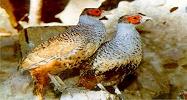Dr. Susan Sharma
 Schedule I, Part III of the Indian Wildlife (Protection) Act, 1972 lists rare and endangered birds which are totally protected throughout the country, live or dead or
part thereof. They include Andaman Teal, Assam Bamboo Partridge, Bazas, Bengal Florican, Blacknecked Crane, Blood Pheasants, , Eastern White Stork, Forest spotted owlet, Jerdon's Courser, Great Indian Bustard, Great Pied Hornbill, Hawks, Hooded Crane, Hornbills,
Houbara Bustard, Humes Bartailed Pheasant, Indian Pied Hornbill, Jerdon's Courser, , Lammergeier, Large Falcons, Large Whistling Teal, Monal pheasant, Mountain Quail, Narcondam Hornbill, Nicobar Megapode, Nicobar Pigeon, Osprey, Peacock-Pheasant, Peafowl or
Indian Peafowl, Pinkheaded Duck, Scalter's Monal Pheasant, Siberian White Crane, Tibetan Snowcock, Tragopan-Pheasant, Whitebellied Sea Eagle, White-eared Pheasant, White Spoonbill, and Whitewinged Wood Duck.
Schedule I, Part III of the Indian Wildlife (Protection) Act, 1972 lists rare and endangered birds which are totally protected throughout the country, live or dead or
part thereof. They include Andaman Teal, Assam Bamboo Partridge, Bazas, Bengal Florican, Blacknecked Crane, Blood Pheasants, , Eastern White Stork, Forest spotted owlet, Jerdon's Courser, Great Indian Bustard, Great Pied Hornbill, Hawks, Hooded Crane, Hornbills,
Houbara Bustard, Humes Bartailed Pheasant, Indian Pied Hornbill, Jerdon's Courser, , Lammergeier, Large Falcons, Large Whistling Teal, Monal pheasant, Mountain Quail, Narcondam Hornbill, Nicobar Megapode, Nicobar Pigeon, Osprey, Peacock-Pheasant, Peafowl or
Indian Peafowl, Pinkheaded Duck, Scalter's Monal Pheasant, Siberian White Crane, Tibetan Snowcock, Tragopan-Pheasant, Whitebellied Sea Eagle, White-eared Pheasant, White Spoonbill, and Whitewinged Wood Duck.
Cheer Pheasant(Catreus wallichii)
Other Names: Wallich's Pheasant
Range: The Himalayas from Afganistan to Nepal
Subspecies: None The Cheer Pheasant is the sole member of the
genus Catreus
Brief Description: Drab in comparison to other pheasant species,
both sexes share the long gray crests. Plumage overall buffy and gray, with black barring; the tail is long and barred buff, gray and brown. Female very similar to the male; lacking spurs, facial skin smaller, duller in plumage and slightly smaller in overall
size.

The only pheasant species that pairs for life in the wild, and where both parents help to raise their young. They have extremely loud territorial calls so that they can communicate
over great distances in the mountains of their homeland.
Habitat: Highland forests and scrublands from 4,000 to 10,000
Feet.
NORMAL LIFESTYLE: It is generally found as small populations within
isolated pockets of suitable habitat. It is a very sedentary bird with a strong attachment to its territory. Its call is a raucous whistle. The species is monogamous and is usually found in pairs or family parties. Clutch size is between 7 and 14 eggs. They
run fast and fly downhill at great speed when disturbed. Ground birds which rarely perch in trees and usually sleep on the ground
Cheer pheasants have been declining in the wild in their natural range for many years.
REASONS FOR DECLINE:
Hunting, habitat loss.
Researchers from WildlifeInstitue of India have reported that sightings of of Cheer pheasants from Great Himalayan National Park (GHNP) are quite limited. " I could observe
this pheasant near Gati Pat in Jiwa Nal valley on the southern facing grassy slopes. Pre-recorded calls of Cheer pheasant were broadcasted at this site during dawn. Two parties of Cheer pheasant responded to these calls. There are potential Cheer pheasant
sites in the grassy slopes of villages in EPA. Using the pre-recorded amplified calls is the best technique to locate/observe this pheasant in its habitat. Otherwise, it is very difficult to see Cheer pheasant in its natural habitat.".
Chail and Majathal sanctuaries in Himachal Pradesh ( H.P) are
reported to be having small populations.
Formerly a private hunting reserve of the Maharaja of Patiala, Chail is now severely degraded (Singh et al., 1990). Nevertheless, it holds an internationally
important population of cheer pheasant (Gaston and Joginder Singh, 1980; Garson, 1983).
Cheer pheasant breeding centres are there at Blossom and Jhaja in H.P.
The World Pheasant Association has worked for nearly 20 years to re-establish this species in the foothills of the Himalayas, in Northern India and in Pakistan where they
had become extinct. Parent-reared young birds from the UK are now successfully re-established and breeding in the Margalla Hills in N. Pakistan and at Jabri in N. India.